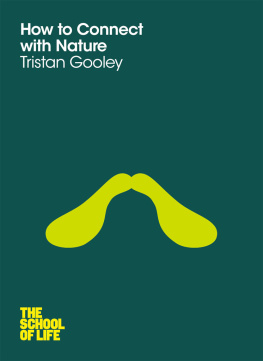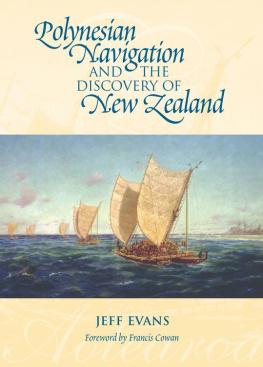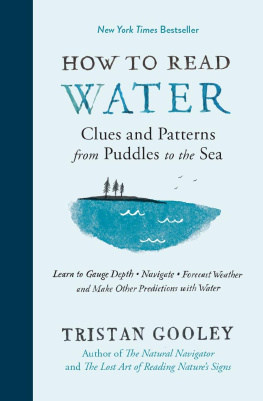Praise for The Natural Navigator
THE NATURAL NAVIGATOR is a wonderfully stimulating book. Tristan Gooley sidesteps technology to celebrate our own powers of observation, and suggests that the art of natural navigation is something we should never have forgotten.
MICHAEL PALIN
THIS WONDERFUL BOOK takes the skill set back several generations to the vanishing (but often surprisingly simple) arts of navigating by sun, moon, starts, and natural phenomena . A must for any lover of the outdoors.
TIM JEPSON,The Telegraph
GOOLEY IS A fine writer with a philosophical passion for the subject, and he occasionally veers into areas that are perhaps not strictly within the remit of the book, but these are effortlessly pleasant diversions that add to the whole. His timing is strong, with anecdotes dropped in just at the right intervals to keep you turning the pages. His advice is at times glorious in its simplicity and fascinating in its execution.
LAURENCE MACKIN,The Irish Times
A DEFINITIVE VOLUME on the subject.
PAUL GELDER,Yachting Monthly
IN A SAT-NAV dominated world, where GPS and a host of other acronyms designed to get us from A to B have overtaken paper maps, it is refreshing to meet someone who understands technology, but prefers to find his way by practicing the rare and ancient art of using natures signposts, from puddle patterns to shadow length . Im hooked.
PAUL EVANS,BBC Wildlife Magazine
AS GOOLEY REMINDS us, navigation is, first of all, about understanding where you are. His marvelous book is a good starting point.
MICK MERRON,Geographical Magazine
GOOLEYS CALM, CONTEMPLATIVE authority on matters solar, lunar, and celestial establishes his guru credentialsbut its his revelations about the clues that lie scattered about the natural environment that really entrance: how puddles drying on paths, the shapes of sand dunes, the graininess of scree on the lee of a slope can all be enlisted to summon compass points to your horizon.
CHRIS BORN,Time Out London

The Natural Navigator
Tristan Gooley
A Watchful Explorers Guide to a Nearly Forgotten Skill

THE NATURAL NAVIGATOR: A Watchful Explorers Guide to a Nearly Forgotten Skill
Copyright Tristan Gooley, 2010, 2011
Illustration on page 100 Science Museum/SSPL
Illustration on page 169 Ocean Planet/Smithsonian
All other illustrations Ruth Murray
All rights reserved. Except for brief passages quoted in newspaper, magazine, radio, television, or online reviews, no portion of this book may be reproduced, distributed, or transmitted in any form or by any means, electronic or mechanical, including photocopying, recording, or information storage or retrieval system, without the prior written permission of the publisher.
The Experiment, LLC
260 Fifth Avenue
New York, NY 10001-6425
www.theexperimentpublishing.com
The Natural Navigator was first published in the United Kingdom by Virgin Books, an imprint of Ebury Publishing, a Random House Group Company. This first revised North American edition is published by arrangement with Random House.
Excerpts from Zen and the Art of Motorcycle Maintenance by Robert Pirsig, published by Bodley Head, reprinted by the permission of the Random House Group Ltd. Excerpts from The Worst Journey in the World by Apsley Cherry-Garrard appear by permission of the Scott Polar Research Institute, University of Cambridge.
The Experiments books are available at special discounts when purchased in bulk for premiums and sales promotions as well as for fundraising or educational use. For details, contact us at info@theexperimentpublishing.com.
Library of Congress Control Number: 2010934221
E-book ISBN 978-1-61519-130-7
Cover design by Davvi I davvi.com
Cover photo Steve Gottlieb/Stock Connection
Text design by Lindsay Nash
Manufactured in the United States of America
First printing January 2011
10 9 8 7 6 5 4 3 2 1
For Sophie, Benedict, and Vincent
Contents

PROLOGUE
Two Journeys
The idea for this book came many years ago and stemmed from a desire to launch a salvage operation. A fundamental human skill was disappearing, as efficient and ubiquitous technology came to dominate our understanding of what it means to find our way. I dreamed of creating a record of the skills of natural navigation, lest they be forgotten altogether. The idea evolved dramatically over the years, as I came to realize that not only was the rare art of natural navigation in danger of extinction, but that the modern world had misunderstood its potential entirely. Nobody seemed to regard what were once practical tools for survival as a contemporary art, but that is how I see it. An art, and one that is at its most beautiful and powerful when it is treated as exactly that, as something exquisite and profound, not a chapter of history or a series of tricks for the modern survivalist.
When I was ten we went on our summer holiday to Bembridge, on the Isle of Wight. At the end of a five-day dinghy sailing course, the instructor approached my sailing partner and me as we prepared our little wooden dinghy for the water.
Where would you like to go today?
The three of us discussed some options, casually, as though this was the most normal thing and then my sailing partner and I launched our Mirror dinghy and set sail. We were going for a picnic on the neighboring beach. I can remember sitting in that boat as we made our own way through the high seas of our imagination (the safety boat was tactfully out of sight). I was only ten years old, and somehow I had garnered the skills to go wherever I wanted. Not where my teachers told me to go, not where my parents wanted me to go, but where I wanted to go. Heady thoughts indeed.
The journeys grew a little more ambitious over time and by my mid-twenties I had some basic experience of trekking, sailing, and flying a light aircraft. It was not the physical activities that were holding my interest, but the science and art behind the ability to go placesthe skills that were allowing me to understand and shape journeys. This art had a name, I discovered: It was navigation.
As part of a desire to pursue my interest in this wonderful art, I decided to try to fly solo and then sail single-handed across the Atlantic. Seven very full years later (during which time I became a father twice over, and my work pressures sky-rocketed) I achieved this on January 1, 2008, and was presented by the Duke of Edinburgh with the Royal Institute of Navigations Award at the Royal Geographical Society.
This book is about a different journey, one that had taken place in the shadow of my more visible Atlantic excursions. It is also the more interesting journey.
In the midst of studying books at night about air law and learning how to find my way using radios, I came to the awkward realization that the technical detail that was the stuff of my studies had little in common with a passion that had been within me since early childhood. It was an uncomfortable feeling, one that frustrated me. I loved going placescreating and experiencing journeyslong before I understood that the word navigation could unite my disparate interests. But it was the sense of connection that the journeys brought that really excited me, the contact with the world around me. I began to read as widely as possible on the subject of instrument-free navigation. My sense of frustration lifted as an alternative interest developed strongly alongside a conventional one.
Next page







